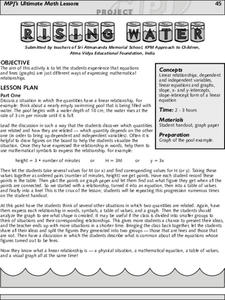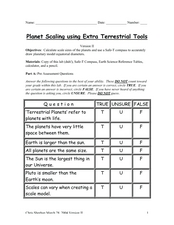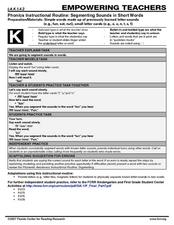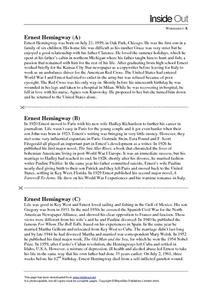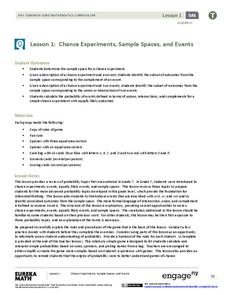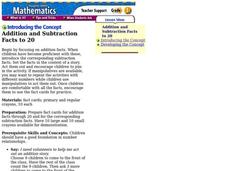Sri Atmananda Memorial School
Rising Water
An engaging, and not to mention attractive, lesson plan has prealgebra and beginning algebra scholars examining linear relationships. They consider the rising water level as a swimming pool is being filled. They do so by charting and...
New York Science Teacher
Planet Scaling using Extra Terrestrial Tools
Your class will use a set scale to convert diameters of planets to the model size, the diagram given to expand on the number of planets drawn as concentric circles, and examine the scale that would be needed to fit the larger planets on...
Curated OER
The Debate Over Stem Cell Research
Students complete a variety of activities as they examine the ethical issues behind stem cell research and cloning. They make their own ethical decisions on both subjects.
Curated OER
Clara Barton's House: Home of the American Red Cross
A fabulous lesson on the life of Clara Barton awaits your class. They describe how Clara Barton founded the American Red Cross, and the role it played in organizing help for those in need. Additionally, young historians explain how...
Curated OER
The Gender of Nouns
Yes, a puzzle! Kids of all ages love completing puzzles, even if they're linked to work. This grid focuses on the definite articles el, la, los, or las. For each of about 40 nouns listed, pupils must find the appropriate square and shade...
Curated OER
Temperature Calculation
In this temperature conversion worksheet, students use the formulas of converting Celsius to Fahrenheit and Fahrenheit to Celsius to calculate the temperature in given problems.
Curated OER
Phonics: Segmenting Sounds in Short Words
F-u-n spells fun. It is a simple word that little learners can sound out as they build phonemic awareness and those early reading skills. This short scripted lesson provides teachers with the basics for teaching how to sound out words.
Curated OER
Gummy Candy Count
Use the book, The Gummy Candy Counting Book, to practice counting up to ten objects in a group. This lesson nicely-combines language arts and math in a way that should lead to effective teaching.
Curated OER
Choose a Number
A quick description of a classroom management technique that allows a teacher to choose participants at random. Assigning grid locations is an easy way to reinforce grid structure as well as giveing an easy way to complete tidying tasks,...
Curated OER
Beginning and Ending Sounds - Lesson 1 of 2
Stamp, slap, and clap! Emergent readers demonstrate their awareness of the initial, medial vowel, and final sounds in spoken, short vowel, single-syllable words with a stamp/slap/clap activity. After identifying the letters and sounds of...
Illustrative Mathematics
Floor Plan
A multi-step problem has learners finding the actual area based on a scale drawing and then converting units at the end. Two different solution choices are listed depending on the preference on which step to start first. Both methods can...
Curated OER
Ernest Hemingway: Inside Out
Introduce class members to basic biographical information about Ernest Hemingway. Groups read three brief paragraphs, and then respond to fact-based questions using material drawn from the readings. The exercise would work well with...
Curated OER
What Counts?
Students practice counting from 1- 10 after listening to a read aloud of a counting book. They create their own counting books.
Curated OER
A Focus on Mechanical Friction
Students explore mechanical friction. They perform experiments to observe the direction of mechanical motion and the difference between rolling and sliding friction. Data results on the experiments are recorded and students answer...
Curated OER
Language Arts: Two Specific Documents
Students are able to read and analyze the essential parts of two specific types of documents, the informed consent document and the position paper, used by scientists to communicate information about their research to two different kinds...
Curated OER
Hands On: Tenths and Hundredths
For this fractions worksheet, students read 6 story problems in which fractions and equivalent fractions are converted. No addition or subtraction is needed; students simply write a fraction that corresponds to the problem.
Curated OER
Five Senses: Brave Little Monster
Pupils identify which of the five senses is being used at a given time. They read "Brave Little Monster" by Ken Baker and then read the story again as they match student-made cards depicting the five senses to moments in the story.
EngageNY
Angles Associated with Parallel Lines
Explore angle relationships created by parallel lines and transversals. The 13th lesson of 18 prompts scholars use transparency paper to discover angle relationships related to transversals. Learners find out that these angles pairs are...
Curated OER
Quick Graphs of Linear Equations
Graph equations of lines using the slope-intercept method or by plotting both x and y intercepts. Determine if two lines are parallel or perpendicular by comparing their slopes. This handout includes step-by-step directions and four...
EngageNY
Chance Experiments, Sample Spaces, and Events
Want a leg up on the competition? Show classes how to use mathematics to their advantage when playing games. Learners calculate probabilities to determine a reasonable scoring strategy for a game.
Houghton Mifflin Harcourt
Addition and Subtraction Facts to 20
First graders act out number stories from number cards. In order to learn about addition and subtraction up to 20 lesson, learners become the manipulatives and line up to show the number stories.
Virginia Department of Education
Lines and Angles
Explore angle relationships associated with transversals. Pupils construct parallel lines with a transversal and find the measures of the angles formed. They figure out how the different angles are related before constructing...
Curated OER
Dice Addition
Using the provided tracing number worksheet, a pair of kindergartners will practice their adding skills. Player A will roll two die, add the sum, and then trace the sum on the worksheet. Player B will take a turn and do the same. The...
Illustrative Mathematics
Making a Clock
Have a fun time teaching children to read analog clocks with this whole-group math activity. Using large sets of the numerals 1-12 and 0, 5, 10...55, the teacher creates a large clock on either the carpet or the white board, explaining...


